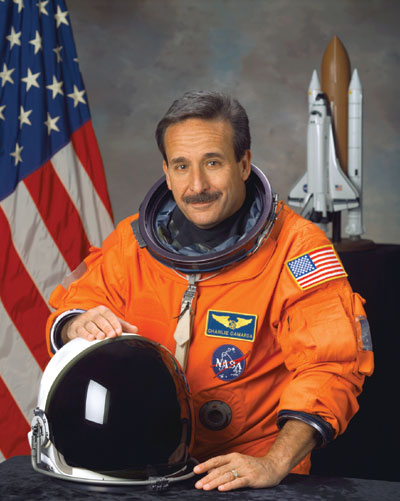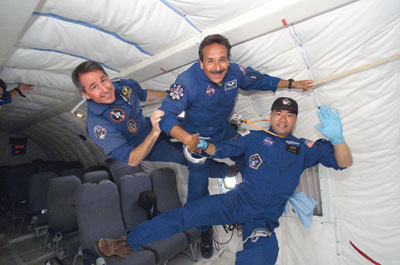
| Reaching for the stars by Sherry Bithell |
 Charlie Camarda Ph.D. '90
Charlie Camarda Ph.D. '90
|
What do you do if you're claustrophobic, afraid of heights, and can't swim?
If you're Charlie Camarda (Ph.D. aerospace engineering '90), you spend hours in a tiny capsule and work hard to pass a water survival course so that you can be launched into space to orbit hundreds of miles above the Earth.
"Sometimes I really wonder about myself," says Camarda.
In July, Camarda was a mission specialist aboard the space shuttle Discovery, fulfilling his childhood dream of becoming an astronaut. "I was lucky to know what I wanted to do from a young age," Camarda recalls. "The Mercury Seven astronauts were my heroes."
He knew, however, that the odds against actually becoming an astronaut were astronomical. "You kind of put that in the back of your mind as you go on through engineering school--it's a dream and you don't know if it will ever happen."
|
Camarda instead set his sights on excelling in engineering research and, after earning his bachelor's degree in aerospace engineering from the Polytechnic Institute of Brooklyn, joined NASA's Langley Research Center in 1975. Three years later, the agency put out a call for civilian astronauts. Camarda applied but wasn't surprised to be rejected due to his limited work experience. He continued working for NASA and went on to earn his master's degree in engineering science from George Washington University and his Ph.D. from Virginia Tech.
Fast-forward to 1996. While attending a NASA-run management class, Camarda met employees from the Johnson Space Flight Center. When he mentioned his childhood dream, one of the Johnson employees responded that there were two weeks until the deadline for the next astronaut class. Camarda immediately applied again--and this time, he was accepted.
"It was like the stars were aligned," he jokes. "I saw this as an opportunity not only to fulfill my dream but also to understand how to build and apply stuff that you’re going to operate in space."
Camarda moved to Houston to begin astronaut training and to wait for his turn to go into space. However, when he was tapped for the Discovery launch nine years later, Camarda's excitement was tempered with uncertainty: his flight would be the first after the Columbia shuttle tragedy. But his reticence wasn't for the reasons one might expect.
"For the first year and a half after the accident, I worked on a solution for some of the key problems with the foam coming off and how we could inspect and repair that," explains Camarda. "When I was first asked to go into space, I wondered, 'Should I take myself out of a role that I think I'm good at?' There wasn't a question of whether the flight would be a success. I was torn between flying the mission and working on the engineering problems." In the end, he decided that flying on the shuttle would teach him more about practical applications for his research.
|
After several more months of training, the day of the long-awaited launch dawned. Camarda admits, "It was a lot less exciting than I'd thought it would be. We trained so much that sitting there on the pad, [reclined] on your back for four hours waiting for the launch was actually very relaxing."
The launch itself was another story. "[Fellow crew member] Wendy Lawrence was sitting next to me, and she said that from the minute the engines lit, all I was doing was laughing and shaking her the whole way up. I was just having a great time--it was like I was on a ride."
The thrill of the journey continued once the shuttle was in orbit. "The thing that struck me the most was the blackness of space," Camarda says. "It looks like a three-dimensional blackness--as if it were this black fog. You can almost cut it with a knife. And the space station was just hanging there in space, looking so pristine and shining with the sun hitting it--it looked like this huge model."
|

Camarda (center) during weightlessness training
with fellow mission specialists Stephen K. Robinson (left)
and Soichi Noguchi (right).
|
| Along for the ride into space was a Virginia Tech flag. "I wanted to take a piece of every one of the institutions of learning that I had attended--my grammar school, my high school, and my universities--because that's the sum total of what enabled me to do what I was able to."
In November, Camarda brought the flag to Blacksburg to present it to the university. While on campus, Camarda also spoke to two engineering classes, stressing the importance of the profession. "When engineering is not done right, [the Columbia disaster] is what happens," he comments. "It's such a tough job. We have to learn our craft and have confidence in what we do and make the right decisions. Also, if something doesn't look right, it's important for people to raise their hands and say, 'Hey, we need to stop and take another look at this.'"
Most importantly, Camarda believes, it's vital for students to do what they love. "You have to have that passion because if you do, you'll be successful. I get up and go to work at ungodly hours because I just love what I do. You can tell from the professors and students around here that when you love what you do, it's not work, it's play."
Case in point: Throughout Camarda's career at NASA, he has received more than 21 NASA awards for technical innovations and accomplishments. He also holds seven patents.
Such successes are the reason, now that Camarda's childhood dream has been realized, he says, "it's time to return to being just an engineer." Given his love for his job, it's hard to imagine Camarda approaching life back on Earth with anything less than the zeal that took him out of this world.
|
|
|
|
When Charlie Camarda began training for the Discovery flight, he found that it's always a small world for Hokies. The lead trainer for new robotic technology was Jeff Sugar (aerospace engineering '97; M.S. industrial and systems engineering '99).
The shuttle's--and Camarda's--mission was heavily dependent on Sugar's know-how. On this test mission, one of the crew's primary goals was to try new vehicle inspection techniques to ensure the safety of future flights. Those techniques relied on inspections conducted from inside the shuttle using a computer-controlled robotic arm, which was operated by Camarda.
"Jeff was teaching us something completely new--we were going to be flying this boom extension to our 50-foot robotic arm," Camarda explains. "It's very close to a fragile structure, the leading edge [of the shuttle], so if you bump it, you could potentially seriously damage the vehicle. Not a lot of pressure on a rookie, right?"
That training paid off once the crew was in space, when Camarda and pilot Jim Kelly improvised an inspection of the entire vehicle before docking at the International Space Station. "Jeff had enough confidence in us on the ground that he let us run these new procedures that we were just doing on the fly. He did a fantastic job teaching us."
|
|